Restaking is a mechanism that allows users to reuse their already staked assets to provide additional security to multiple blockchain networks or applications. This approach enables users to recycle their existing staked assets, improving scalability and liquidity while also earning extra rewards.
The Restaking Stack is a conceptual framework that systematically categorizes the primary components of the restaking ecosystem, including the Based Blockchain Network, Staking Infrastructure, Staking Platform, Restaking Infrastructure, Restaking Platform, and Restaking Applications.
Restaking Infrastructure provides the technical foundation for enabling restaking, allowing assets that are already staked to be used to secure other protocols or networks. Notable projects in this space include Ethereum's EigenLayer, Bitcoin's Babylon, and Solana's Solayer. These projects focus on ensuring liquidity, enhancing security, and providing network scalability.
Restaking redefines blockchain security and is rapidly growing as an ecosystem. Its ability to enhance scalability and liquidity through economic security makes it highly appealing, though concerns about the risks and profitability of the restaking model remain.
The next part of this series will explore restaking platforms and applications, which are crucial to the potential mass adoption of the restaking ecosystem.
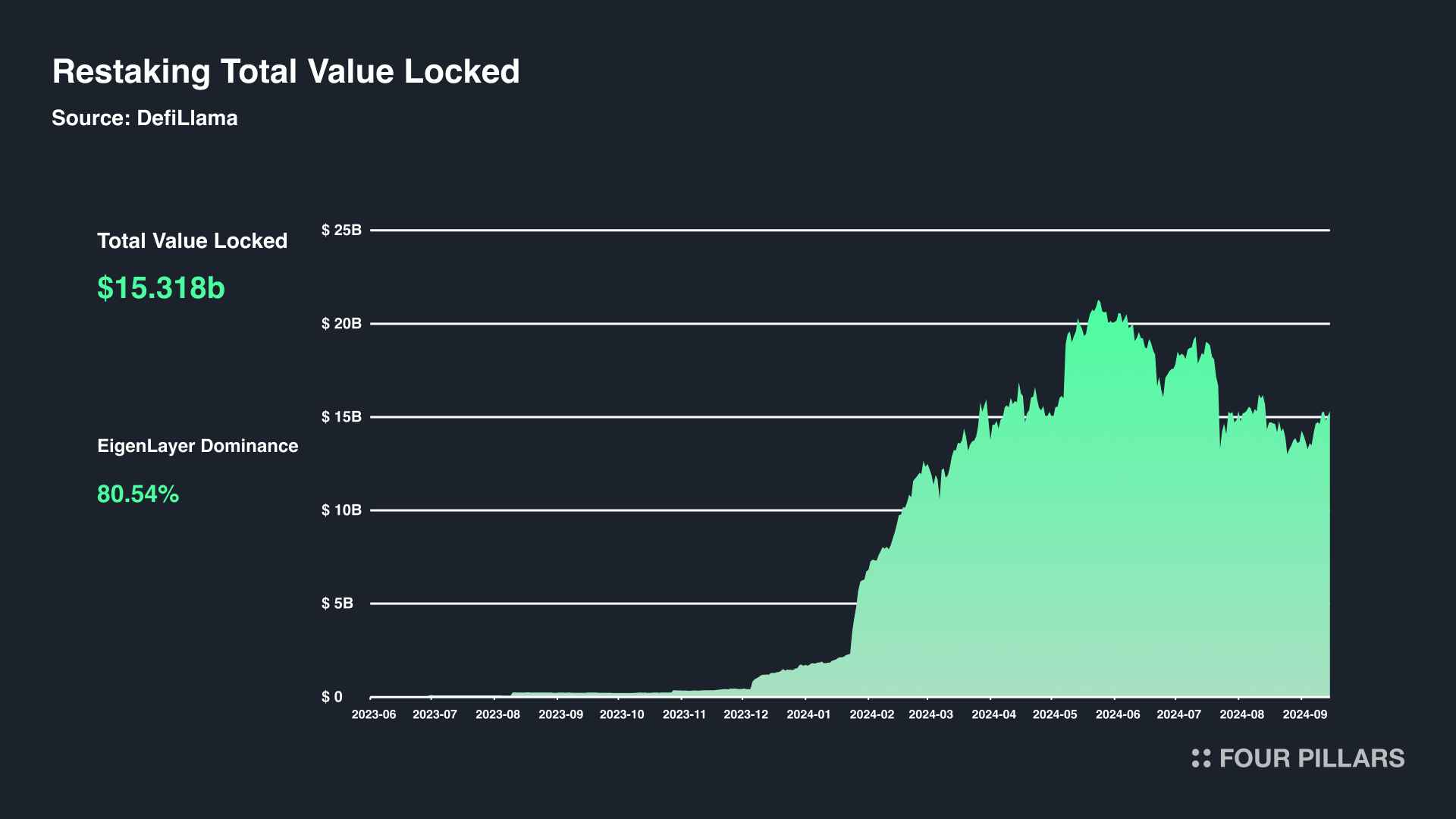
As of September 28, 2024, the total value locked (TVL) in the restaking ecosystem, led by EigenLayer, is approximately $15.3B. This figure surpasses the TVL of $13B held by the crypto lending platform Aave, and represents more than half of Lido's TVL ($26.48B), a leading Ethereum liquid staking platform. This highlights the impressive growth of the restaking ecosystem.
Given this, you might wonder what restaking is that has captured the interest of crypto holders and driven such growth. To answer this question, this two-part series aims to explain what restaking is, the perspective from which to view the expanding restaking ecosystem, and the intriguing projects within it.
This series starts with an overview of what restaking is, a definition of the restaking stack centered around robust restaking infrastructure, and an exploration of projects categorized under restaking infrastructure and their unique characteristics.
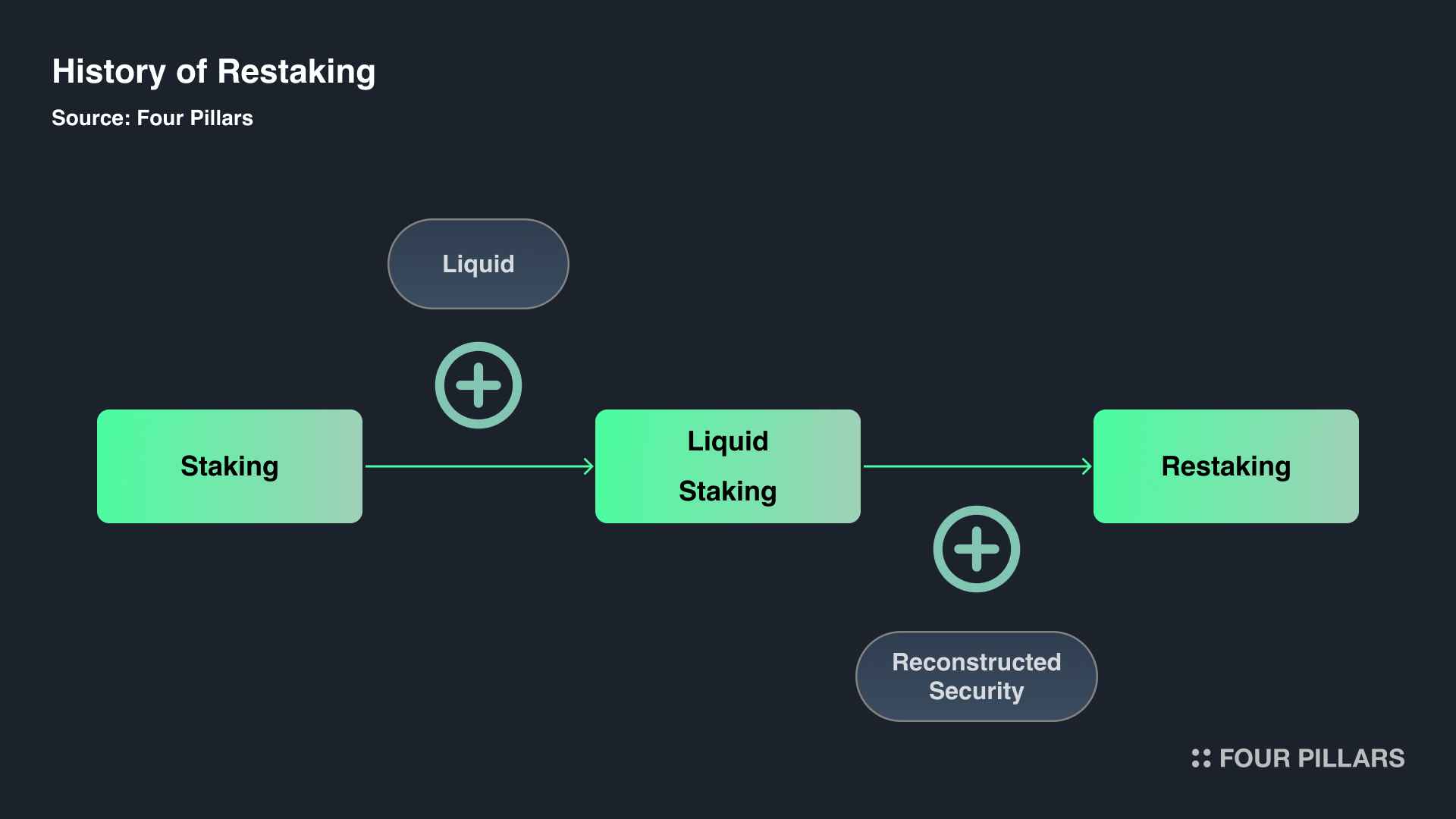
When Ethereum transitioned from Proof of Work (PoW) to Proof of Stake (PoS) with the much-anticipated upgrade known as The Merge, many ETH holders staked their ETH to support the network’s stability and earn staking rewards. This process led to the emergence of various staking services and platforms.
The first demand was for staking pools. Staking the required minimum of 32 ETH posed a significant challenge for smaller Ethereum holders. To address this, staking pools were developed, allowing those with less than 32 ETH to participate in Ethereum staking.
The next issue concerned liquidity. When staking ETH, the assets are locked in a smart contract, leading to reduced liquidity. During the initial phase of the PoS transition, staked ETH could not even be withdrawn, which effectively meant near-zero liquidity for staked ETH. To overcome this, services like Lido and Rocket Pool issued Liquid Staking Tokens (LSTs). LSTs matched the value of the staked ETH, enabling stakers to use them in other DeFi services as a proxy for their staked ETH. In essence, LSTs allowed users to regain some liquidity for their staked assets.
With liquidity secured through LSTs, new opportunities emerged for utilizing these tokens. However, LSTs were mostly limited to the Ethereum DeFi ecosystem and were not used for securing extended networks built on Ethereum, such as L2s. This created new challenges for Ethereum’s security model, such as:
Scalability Issues: Ethereum’s limited transaction processing capacity means that, during periods of high demand, the network can become congested, leading to significantly increased transaction fees. This made it difficult for dApps and DeFi platforms to accommodate large numbers of users. Layer 2 (L2) solutions emerged to address this issue, but they required their own security and verification mechanisms.
Need for Additional Security: Ethereum's fundamental security mechanisms operate at the protocol level and rely on participants staking ETH to maintain network security. However, Ethereum’s built-in security is not always sufficient to meet the specific security needs of various L2s and applications, necessitating additional layers of security for each application.
Liquidity Constraints: While Ethereum’s adoption of PoS activated staking mechanisms, a key issue remained: staked assets were used solely for network security. Staked ETH, for example, could not be leveraged for other useful functions or applications. This limited liquidity and restricted the ability of network participants to explore additional revenue-generating opportunities.
These challenges highlighted the need for a new security mechanism tailored to the current state of Ethereum and PoS blockchains.
The demand for a new security approach eventually led to the concept of restaking.
“Restaking is the latest answer to the security question at the heart of everything in crypto: how to use economic games to protect decentralized computing systems.”
As described in the quote, restaking uses financial engineering principles to enhance blockchain security through economic security.
Before delving deeper into restaking, it's important to understand how PoS blockchains maintain security. Many blockchains, including Ethereum, have adopted PoS, where a common attack method is for an adversary to accumulate enough staked assets to influence the network. The cost to compromise a blockchain is generally proportional to the total value staked in the network, serving as a deterrent against attacks.
Restaking takes this concept further, aiming to apply economic security more broadly. In major protocols like Ethereum, substantial capital is already staked. Restaking repurposes this capital to offer enhanced security and functionality at the L2 or application level. Because of the added security benefits, restakers can earn greater rewards than through traditional staking alone. Thus, restaking serves as a solution to the challenges outlined above:
Scalability: Restaking allows L2 solutions and other applications to tap into the security of a major blockchain’s staked resources. This enables L2 solutions to maintain higher levels of security without having to build independent mechanisms, utilizing the staked capital from the mainnet instead.
Enhanced Security: Restaking allows the staked resources of a major blockchain to be used not only for securing the mainnet but also for validating and securing functions at the application level. This creates a more robust and comprehensive security framework.
Liquidity Enhancement: Restaking is designed to allow staked mainnet assets to be repurposed for other uses. For example, staked assets can be employed in verification tasks across different networks or applications, increasing the overall liquidity and utility of the security ecosystem while providing additional rewards to participants.
In summary, restaking emerged as a response to the limitations of PoS mainnets like Ethereum, seeking to enable these networks to support more participants while offering enhanced security and liquidity.
A notable early implementation of the restaking concept is Interchain Security (ICS). Cosmos operates an ecosystem where multiple independent blockchains interact through the Interchain concept. Each chain, however, had to maintain its own security, which posed a burden. ICS addressed this by allowing blockchains in the Cosmos ecosystem to share security resources.
Validators of the Cosmos Hub are responsible for securing the network, and new or smaller chains can leverage this security, eliminating the need to establish their own validator networks. This approach reduces security costs and helps new blockchain projects start more easily within the Cosmos ecosystem. However, challenges like increased infrastructure costs, limited utility of native tokens, and high profitability demands from consumer chains limited ICS’s overall success.
Nevertheless, these efforts paved the way for the Ethereum ecosystem's EigenLayer, which has since become a leader in the restaking industry. Therefore, to understand restaking thoroughly, studying EigenLayer, which is well-established within the Ethereum ecosystem, is an excellent starting point. Let’s dive deeper into EigenLayer and the restaking ecosystem.
1.3.1 From Fragmented Security to Reconstructed Security
How does restaking fundamentally work to offer stronger security and liquidity?
“If I have seen further it is by standing on ye sholders of Giants.”
Isaac Newton
This famous quote by Isaac Newton acknowledges the contributions of past scientists to his own achievements. More broadly, it suggests that “making use of existing resources is often a wise choice.”
Many current blockchain services rely on large L1 networks, leveraging their ecosystems, trust, and security resources. However, choosing a less established network or attempting to become a major player independently can be risky, as these projects might stumble before reaching their full potential.
To illustrate this with EigenLayer, let’s consider a scenario depicted in the following diagram.

In the diagram, two ecosystems each have $13B in staked capital. On the left, Ethereum and Actively Validated Services (AVS, a type of middleware network service) are not interconnected, while on the right, they are linked through EigenLayer.
Left Ecosystem: Here, Ethereum and AVS are not directly connected, so while value can be transferred between networks via bridges, this does not correlate with shared security. Thus, Ethereum and AVS cannot share economic security, leading to fragmented security. An attacker would likely target the network with the lowest staked capital. This results in security fragmentation, where the Cost of Corruption (CoC) is aligned to the minimum required amount. This situation creates a competitive environment among services rather than synergy, potentially undermining Ethereum’s economic security.
Right Ecosystem: What if Ethereum and AVS were interconnected? EigenLayer answers this by integrating Ethereum and AVS through the concept of restaking, merging fragmented security into a reconstructed form. This integration has two benefits: AVS services can share the capital of the Ethereum network rather than competing for it, and all AVS services can fully utilize the shared economic security. This effectively creates an environment where these “giants” combine their strengths, allowing them to see further together.
1.3.2 Pillars of Restaking (feat. EigenLayer)
With this explanation, we can understand that AVS services can inherit Ethereum’s economic security, allowing them to leverage significant security at a reduced cost. However, this complex financial ecosystem relies on various roles to function smoothly. Let’s delve into these roles:
Actively Validated Services (AVS): AVS are services that require a decentralized validation system, such as DA layers, sidechains, or oracle networks. AVS rely on node operators to maintain network security by running nodes reliably. AVS uses two mechanisms: slashing, where a portion or all of a staked amount is forfeited for poor performance, and rewards for successful operations. AVS can leverage Ethereum’s security without building separate trust networks by utilizing restaked ETH.
Restaker: Restakers are entities that restake native ETH or LSTs staked on the Ethereum Beacon Chain. If restakers are uncertain about choosing a specific AVS or seek additional rewards, they can delegate their restaked capital to node operators. In this case, the restaker entrusts their capital to the nodes operated by node operators, earning restaking rewards from them.
Node Operator: Node operators receive delegated restaked capital from restakers, operating nodes to perform the validation tasks required by AVS. Node operators establish and run nodes with enhanced security using restaked capital. They play a crucial role in maintaining the reliability and security of AVS, receiving both restaking and node operation rewards in return.
1.3.3 Combine into One
EigenLayer integrates these roles into an open marketplace structure, allowing each role to operate freely based on economic principles.
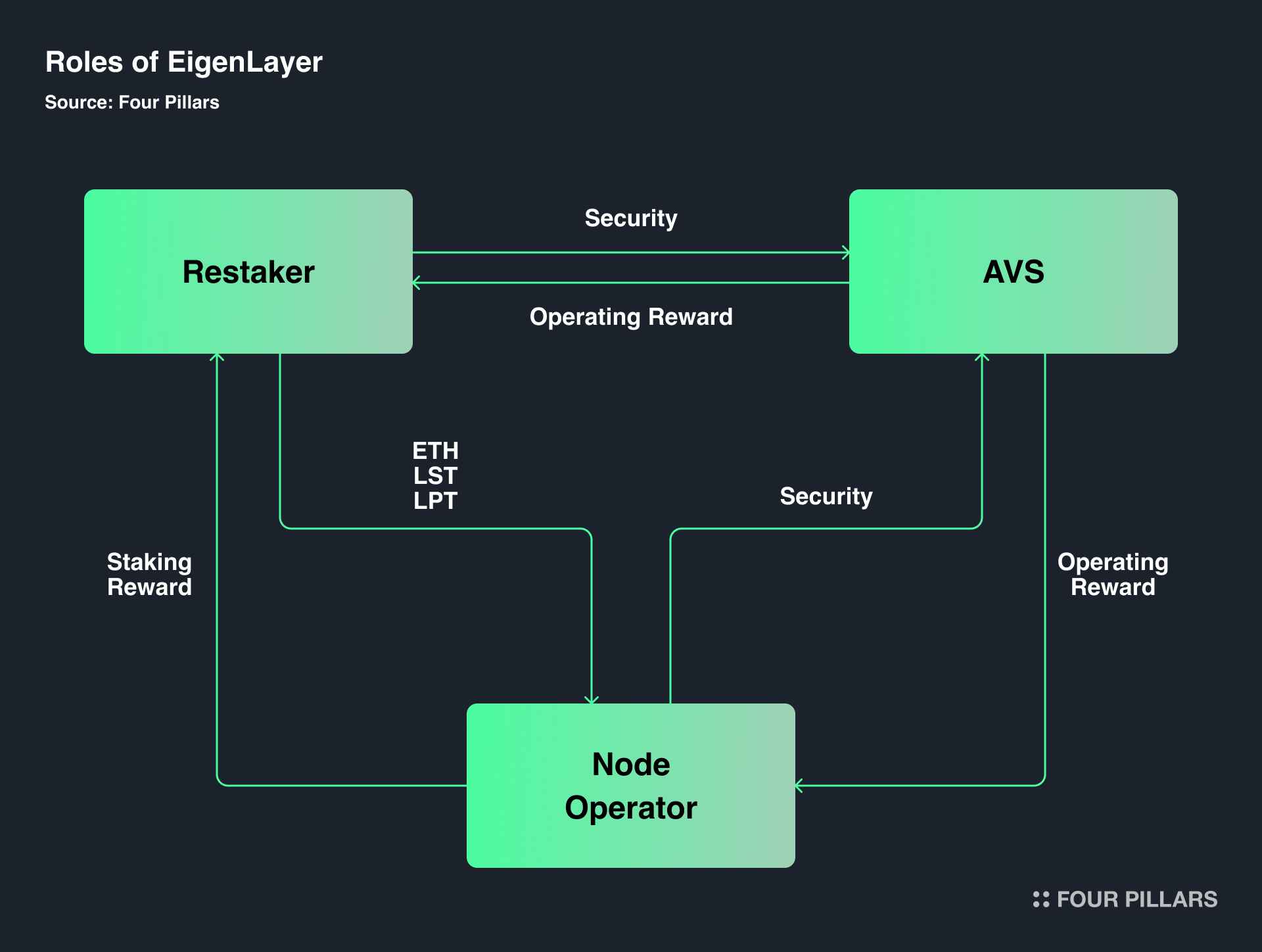
In this setup, restakers delegate their assets, such as ETH, LSTs, or LPTs, to node operators, who then secure AVS services with their nodes and earn rewards. Meanwhile, AVS pays operational rewards to node operators for their security contributions, ensuring network safety and trust.
1.3.4 Strengthening Restaking Ecosystem
EigenLayer serves as a prime example of restaking, offering a comprehensive view of the concept. Most emerging restaking services adhere closely to the core principles of restaking, making EigenLayer an effective reference for understanding the restaking model.
With EigenLayer at the forefront, the restaking ecosystem is expanding. This growth isn't just in scale; the ecosystem is becoming increasingly nuanced, with more specific roles and classifications emerging. This allows for a deeper understanding of the expanding ecosystem. In the next chapter, we’ll take a closer look at the Restaking Stack and explore the projects within each category.
Since the restaking ecosystem is still actively evolving, it can be challenging to clearly delineate each category. However, as the ecosystem matures and positions are stabilized, it will foster the development of more advanced projects. Using available data and my perspective, I will introduce a framework for categorizing the restaking ecosystem—the Restaking Stack.
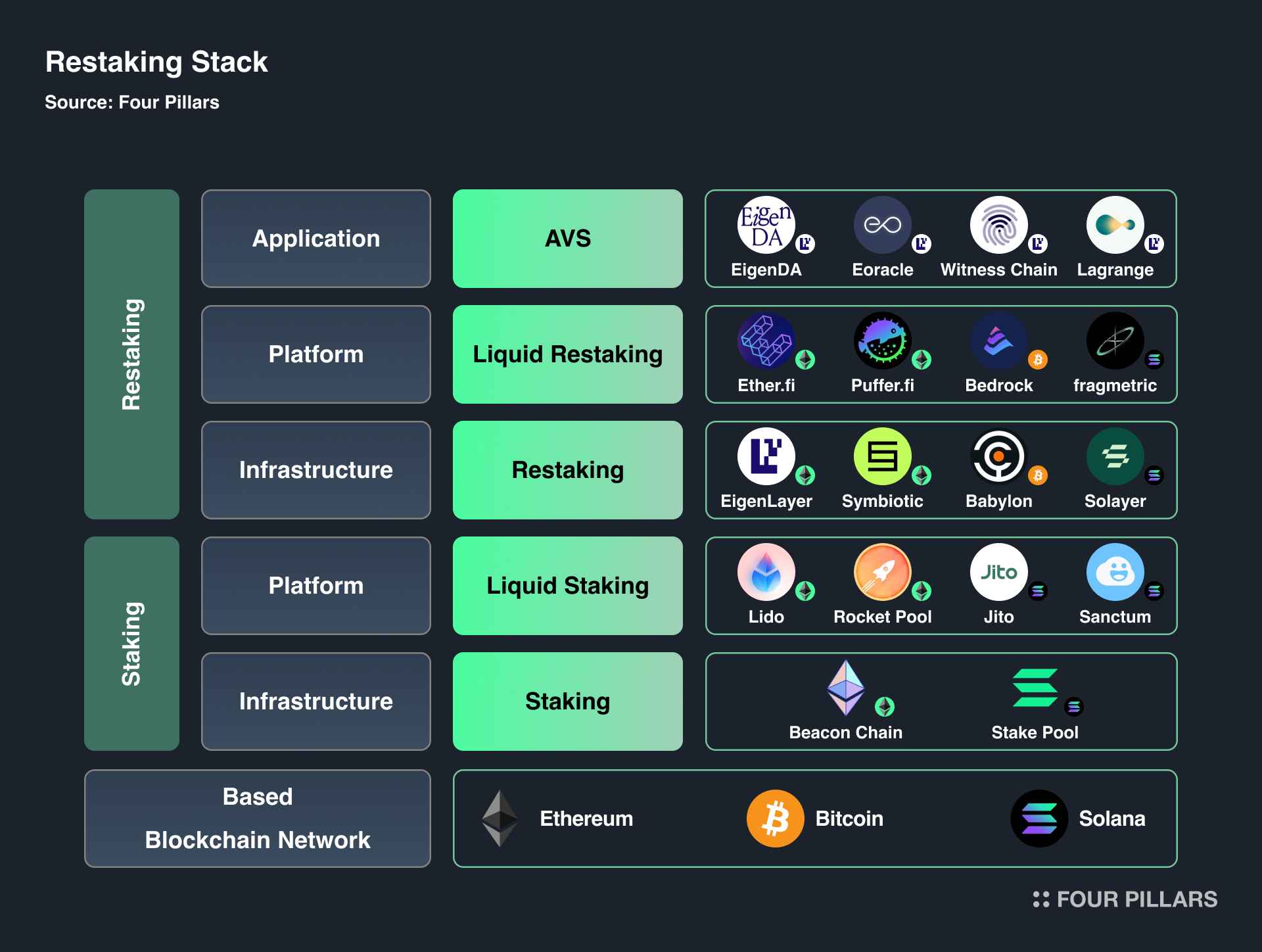

The Based Blockchain Network layer serves as the foundation for staking or restaking, featuring blockchains with their own native tokens and security mechanisms. PoS-based blockchains like Ethereum and Solana provide stable and efficient environments for staking and restaking, given their substantial TVL. Although Bitcoin is not PoS-based, its dominant share of blockchain capital has prompted ongoing efforts to incorporate its economic security into restaking.
Ethereum: Ethereum is the primary blockchain network for restaking, playing a key role in the ecosystem. Thanks to its PoS system and smart contract capabilities, Ethereum offers users opportunities to participate in various restaking activities with their native ETH through platforms like EigenLayer.
Bitcoin: Bitcoin, with its PoW mechanism, lacks native staking capabilities typical of PoS blockchains. Nevertheless, due to its global adoption and strong security, initiatives like Babylon aim to integrate Bitcoin’s substantial capital into the restaking ecosystem, using its economic security to bolster other blockchains. Projects like Babylon allow the use of Bitcoin's capital without wrapping or bridging, thus enabling Bitcoin staking directly from its blockchain.
Solana: Solana, known for high-performance and low transaction costs, offers a conducive environment for staking, DeFi, NFTs, and restaking. As Solana’s staking infrastructure continues to grow, platforms like Solayer are emerging, aiming to establish a prominent role for Solana within the restaking ecosystem by providing unique restaking models tailored to Solana's strengths.

The Staking Infrastructure layer includes systems that enable participants to stake their native tokens, thereby contributing to the blockchain network's security and efficiency. These infrastructures are central to PoS-based consensus mechanisms, enabling the decentralized process of block validation and generation. Participants stake their assets to become validators, helping maintain network stability and earning rewards. Additionally, staking infrastructures monitor validator behavior, penalizing misconduct through slashing to enhance security.
Beacon Chain: The Beacon Chain plays a crucial role in the Ethereum network that has transitioned to PoS, improving scalability, security, and energy efficiency. Unlike the previous PoW-based Ethereum, the Beacon Chain operates around validators who stake native ETH. It selects validators and manages the process of proposing and validating blocks. This shift reduces the high energy consumption of PoW-based mining while maintaining the decentralization of the network and improving efficiency. Additionally, the Beacon Chain oversees users participating as validators by locking up their staked native ETH, and it monitors whether the validators are validating blocks correctly. If a validator engages in misconduct, they face penalties through a process called slashing, which involves the forfeiture of their staked ETH.
Stake Pool: Solana’s stake pools enhance network security and simplify user participation in staking. They aggregate smaller SOL stakes, allowing users to collectively support a single validator. Through this process, users who delegate their stake to validators earn rewards as these validators create blocks or validate transactions. Stake pools also improve network stability by distributing staked SOL across reliable validators.

The Staking Platform layer includes services that enable users to contribute to the security and operation of a blockchain network while maintaining the liquidity of their assets. These platforms play a key role in PoS blockchains by offering simple services that allow users to stake native tokens and earn rewards. Beyond merely locking up assets, staking platforms also provide liquid staking, which tokenizes staked assets, allowing users to utilize these assets in DeFi services. This structure enables users to maintain liquidity while participating in network operations and maximizing rewards. Through these functionalities, staking platforms simplify the user experience and make it easier for more users to participate in staking.
Lido: Lido is one of the most popular liquid staking platforms in the Ethereum ecosystem, allowing users to stake their native ETH and receive stETH in return. This liquid token maintains the value of the staked ETH, enabling users to access additional rewards through other DeFi services. Lido's focus on Ethereum has since expanded to support networks like Polygon's PoS network.
Rocket Pool: Rocket Pool is a community-owned decentralized staking platform for Ethereum, compatible with native ETH staking. Initially conceived in 2016 and launched in 2021, it aimed to provide solutions for users without the technical capability to run a node or the financial means to meet the 32 ETH requirement. Rocket Pool is committed to building a liquid and reliable platform that allows users to leverage their staked assets across various services.
Jito: Jito is a liquid staking platform for Solana, offering users MEV (Maximal Extractable Value) rewards. Users can stake their native SOL through Jito’s stake pool and receive JitoSOL tokens, which maintain liquidity while accumulating staking and MEV rewards. Jito aims to optimize returns for users holding JitoSOL, contributing to the richness of the Solana DeFi ecosystem.
Sanctum: Sanctum operates on Solana’s fast speed and low fees, offering enhanced security as a staking platform through open-source and multi-signature frameworks. It allows users to utilize staked SOL across DeFi services. By integrating the liquidity of various LST pools, it addresses liquidity fragmentation issues, enabling users to access a richer liquidity pool. Notably, through the Infinity Pool, users can deposit LST or SOL, receive INF tokens, and simplify staking and liquidity provision. Additionally, Sanctum runs a rewards program called Wonderland, which encourages active user participation by providing points and rewards for performing specific tasks or using the platform.

The Restaking Infrastructure layer is critical for enhancing the economic security of blockchain networks while providing scalability and flexibility. It enables users to reuse their already staked assets to secure multiple networks or applications, offering the opportunity for restakers to participate in various services while maximizing rewards. Applications built on top of this infrastructure can secure more robust security frameworks and expand their functionalities by leveraging restaked assets.
The restaking infrastructure also supports restaking platforms and applications by allowing them to create tailored staking and security models. This enhances scalability and interoperability across blockchain ecosystems, positioning restaking as a pivotal technology for sustaining decentralized networks.
Below are examples, with more details on restaking infrastructure provided in Chapter 3.
EigenLayer: EigenLayer is a restaking infrastructure built on Ethereum, enabling users to restake their native ETH or LSTs to secure additional applications and earn extra rewards. By reusing staked ETH across various services, EigenLayer reduces the capital requirements for participation while significantly enhancing the trustworthiness of individual services.
Symbiotic: Symbiotic is a restaking infrastructure that offers an open and accessible shared security model for decentralized networks. It enables builders to create custom staking and restaking systems with modular scalability and a decentralized operator reward and slashing mechanism, providing networks with enhanced economic stability.
Babylon: Babylon connects Bitcoin’s robust economic security to other blockchains, such as Cosmos, aiming to strengthen security and facilitate cross-chain interoperability. Babylon’s integration allows networks connected through it to leverage Bitcoin's proven security for more secure transactions. It utilizes Bitcoin’s hash power to enhance finality and offers a suite of protocols for securely sharing Bitcoin’s security with other networks.
Solayer: Solayer builds on Solana's network by leveraging economic security to expand app chains, offering application developers custom block space and efficient transaction alignment. It utilizes restaked SOL and LSTs to maintain network security while enhancing specific network functions, aiming to support scalable application development.

The Restaking Platform layer includes platforms that provide additional liquidity or combine restaking assets with other DeFi services, enabling users to maximize their rewards. These platforms often issue Liquid Restaking Tokens (LRTs) to further enhance the liquidity of restaked assets. They also facilitate user participation in restaking with flexible management models and reward systems, thereby contributing to the stability and decentralization of the restaking ecosystem.
Ether.fi: Ether.fi is a decentralized restaking platform that allows users to maintain direct control over their restaking keys. It offers a service marketplace where node operators and restakers interact. The platform issues eETH as a liquid staking token and seeks to decentralize Ethereum’s network through a multi-step restaking process and node service provisioning.
Puffer.fi: Puffer.fi is a decentralized native liquid restaking platform based on EigenLayer. It allows anyone with less than 32 ETH to stake their Ethereum native tokens, maximizing rewards through integration with EigenLayer. Puffer.fi provides high capital efficiency, offering liquidity and PoS rewards through its pufETH token. Restakers can receive stable returns without needing complex DeFi strategies, and Puffer.fi’s security mechanisms ensure asset safety.
Bedrock: Bedrock supports a range of asset types in its liquid restaking platform, developed in collaboration with RockX. It offers additional rewards through restaking assets like wBTC, ETH, and IOTX. For instance, uniBTC restakes BTC for security on the Ethereum network, while uniETH restakes ETH similarly, maximizing rewards through EigenLayer. Bedrock employs a capped tokenomics structure that prevents total issuance growth, aiming to increase token value over time.
Fragmetric: Fragmetric is a liquid restaking platform on the Solana ecosystem, addressing issues of reward distribution and slashing rates by utilizing Solana's token extension capabilities. Its fragSOL token sets a new standard for restaking on Solana, offering a platform structure that enhances both security and profitability.

The Restaking Application layer includes decentralized services and applications that use restaked assets to enhance the security and functionality of existing blockchain infrastructure. These applications leverage restaking to ensure economic security while focusing on providing specific functions, such as data availability storage, oracles, physical infrastructure verification, and cross-chain interoperability.
By allowing validators on Ethereum and other blockchain networks to restake their assets across multiple services, restaking applications reduce capital costs while improving security and scalability. They also ensure data integrity and security through decentralized processes, applying economic incentives and penalties to ensure reliability. These applications enhance the scalability and efficiency of blockchain systems and foster interoperability between diverse services.
EigenDA: EigenDA is a high-scalability data availability (DA) storage solution for Ethereum rollups, integrated with EigenLayer. EigenLayer requires operators to stake a bond to participate, penalizing those who fail to store and verify data correctly. This incentivizes decentralized and secure data storage, with EigenDA's scalability and security enhanced through EigenLayer’s restaking mechanism.
Eoracle: Eoracle is an oracle service within the EigenLayer ecosystem that utilizes restaked ETH and Ethereum validators to provide data verification. Eoracle aims to create a decentralized competitive marketplace for data providers and users, automating data verification and enabling smart contracts that integrate external data sources.
Witness Chain: Witness Chain supports the development of new products and services for various applications and Decentralized Physical Infrastructure Networks (DePIN). It uses the DePIN Coordination Layer (DCL) module to convert physical properties into verifiable digital proofs. Within the EigenLayer ecosystem, EigenLayer operators run DePIN Challenger Clients, ensuring a reliable environment for its verification processes.
Lagrange: Lagrange is the first zero-knowledge AVS on EigenLayer. Its State Committees are a decentralized network of nodes providing security for cross-chain interoperability using zero-knowledge technology. Lagrange's ZK MapReduce solution supports efficient cross-chain operations while maintaining security and scalability. It strengthens cross-chain messaging and rollup integration, leveraging EigenLayer’s economic security to enhance performance.
Through this overview of the Restaking Stack and project examples, we see that as the restaking ecosystem matures, it becomes more structured, offering greater depth of understanding. How about taking a closer look at these emerging categories? In this series, we’ll first focus on restaking infrastructure, with other components to be covered in the next part.
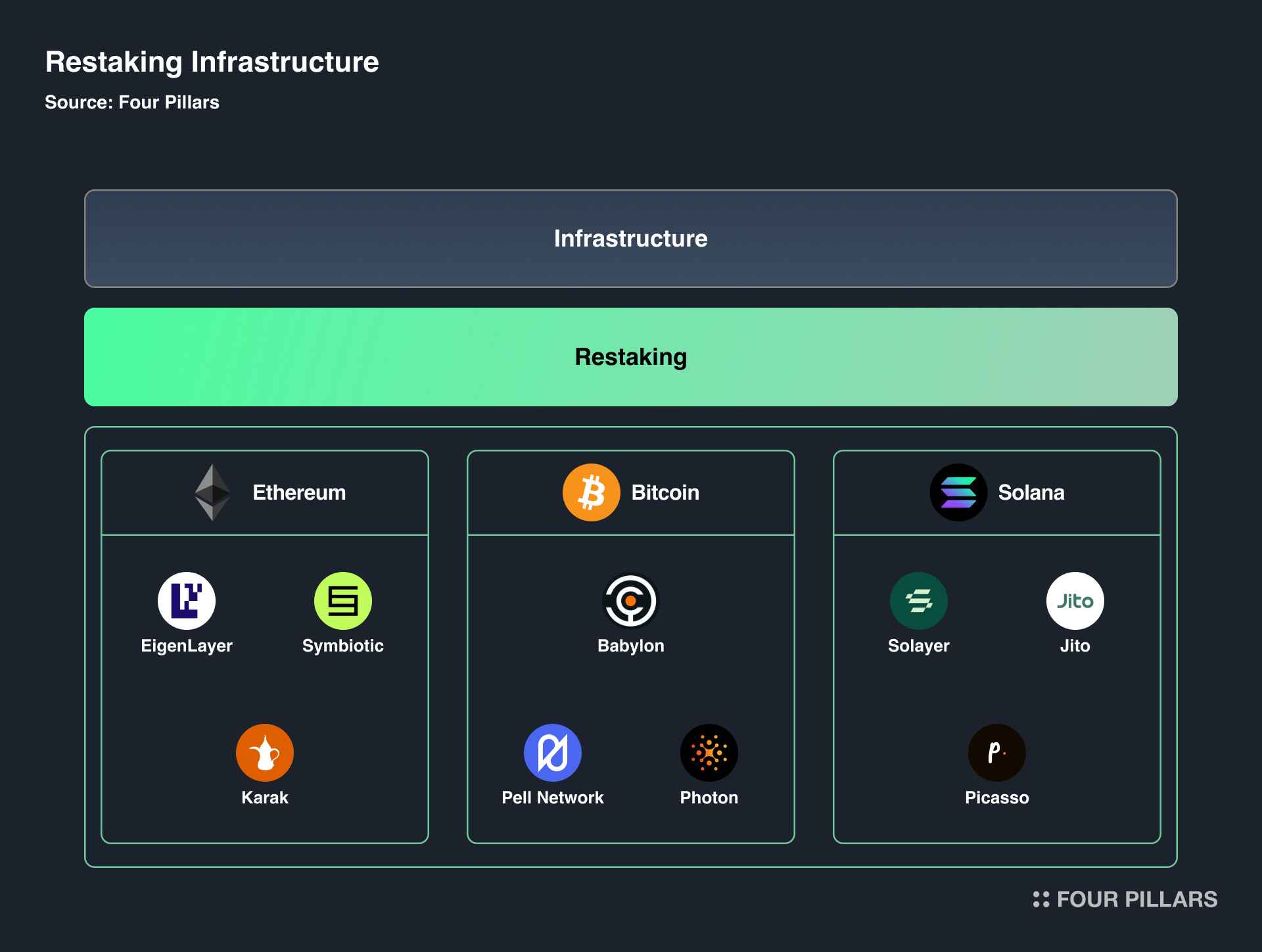
The restaking infrastructure serves as a foundational framework that enables the repurposing of staked assets across different networks and protocols to enhance network security and maximize utility. As restaking concepts have gained traction, major blockchain networks like Ethereum, Bitcoin, and Solana have developed infrastructures tailored to their unique characteristics. In this section, we’ll explore the reasons behind the emergence and evolution of restaking infrastructure in each of these networks, the advantages and challenges they face, and the impact of various projects on the restaking infrastructure.
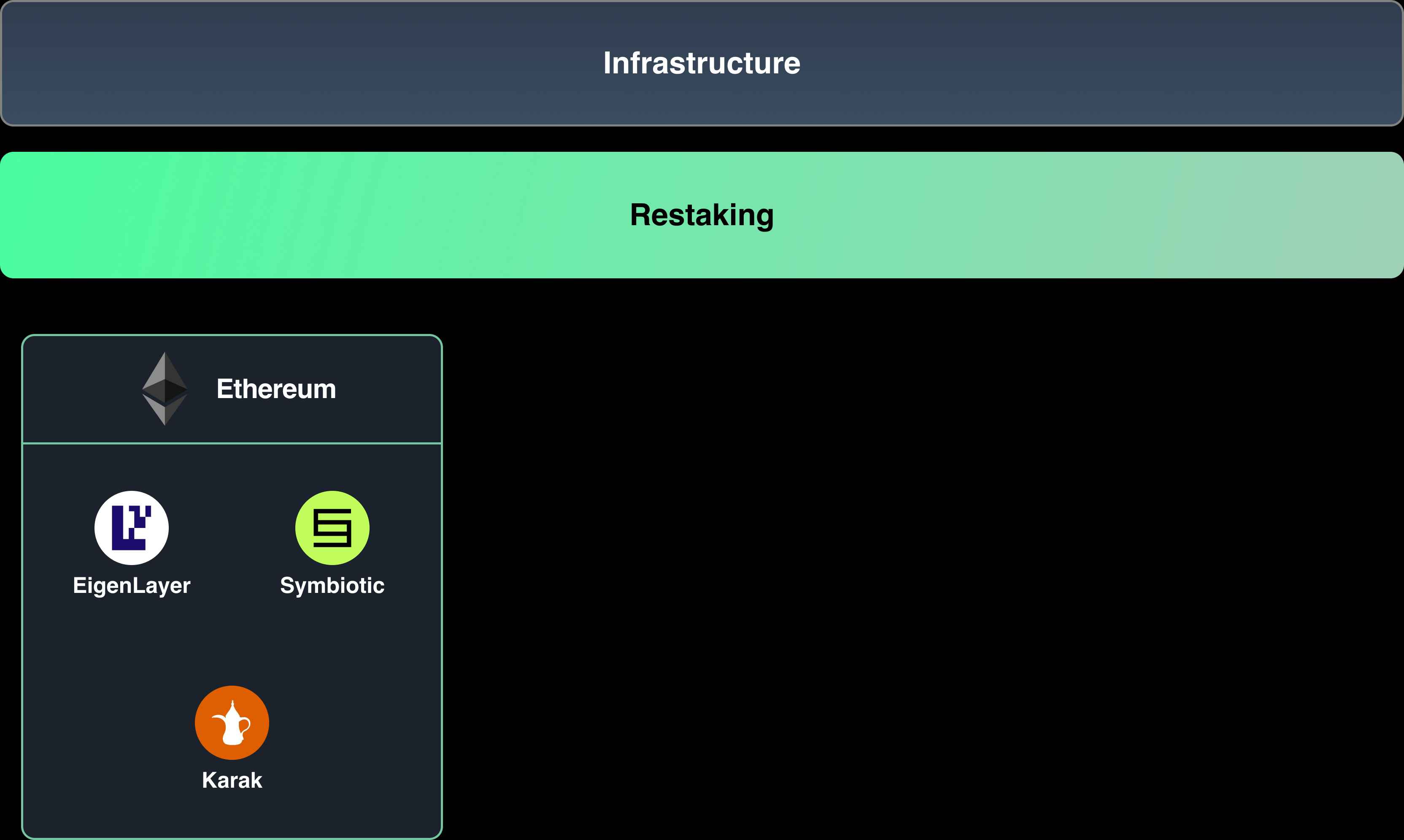
With its transition from PoW to PoS during “The Merge” upgrade, Ethereum laid the groundwork for the growth of restaking infrastructure. Ethereum’s PoS model relies on staked assets for network security, but the ability to repurpose these assets for other protocols has significantly increased interest in restaking.
Ethereum’s primary focus has been on scalability, which it had been achieving through L2 solutions. However, as Ethereum founder Vitalik Buterin pointed out, this approach resulted in security fragmentation, ultimately weakening Ethereum’s security model. EigenLayer emerged as the first solution to address this issue through economic security, allowing staked Ethereum assets to be used in other protocols to enhance security and scalability.
EigenLayer provides restaked Ethereum assets across different protocols while maintaining basic security and leveraging a large network of operators for stable economic security. It supports native ETH restaking and plans to extend to LSTs and ERC-20 tokens, offering a potential solution to Ethereum’s scalability challenges.
The restaking concept is spreading within the Ethereum ecosystem, with other projects aiming to address Ethereum’s limitations. Symbiotic, for example, enhances Ethereum's security by integrating with other DeFi services. Symbiotic supports a broad range of assets for restaking, including LSTs like wstETH, as well as assets such as sUSDe and ENA through partnerships with Ethena Labs. This allows users to provide additional security resources through restaking and improves Ethereum’s PoS security. Furthermore, Symbiotic issues ERC-20 tokens like LRT to offer flexible reward structures, allowing efficient use of restaked assets across various protocols.
Another restaking infrastructure, Karak, aims to address Ethereum’s structural inefficiencies that challenge restaking operations. Karak offers multi-chain support, enabling users to deposit assets across chains like Arbitrum, Mantle, and Binance Smart Chain. It supports the restaking of ERC-20 tokens, stablecoins, and LSTs in a multi-chain environment. Karac uses its own L2 chain to store assets, maintaining security while maximizing scalability.
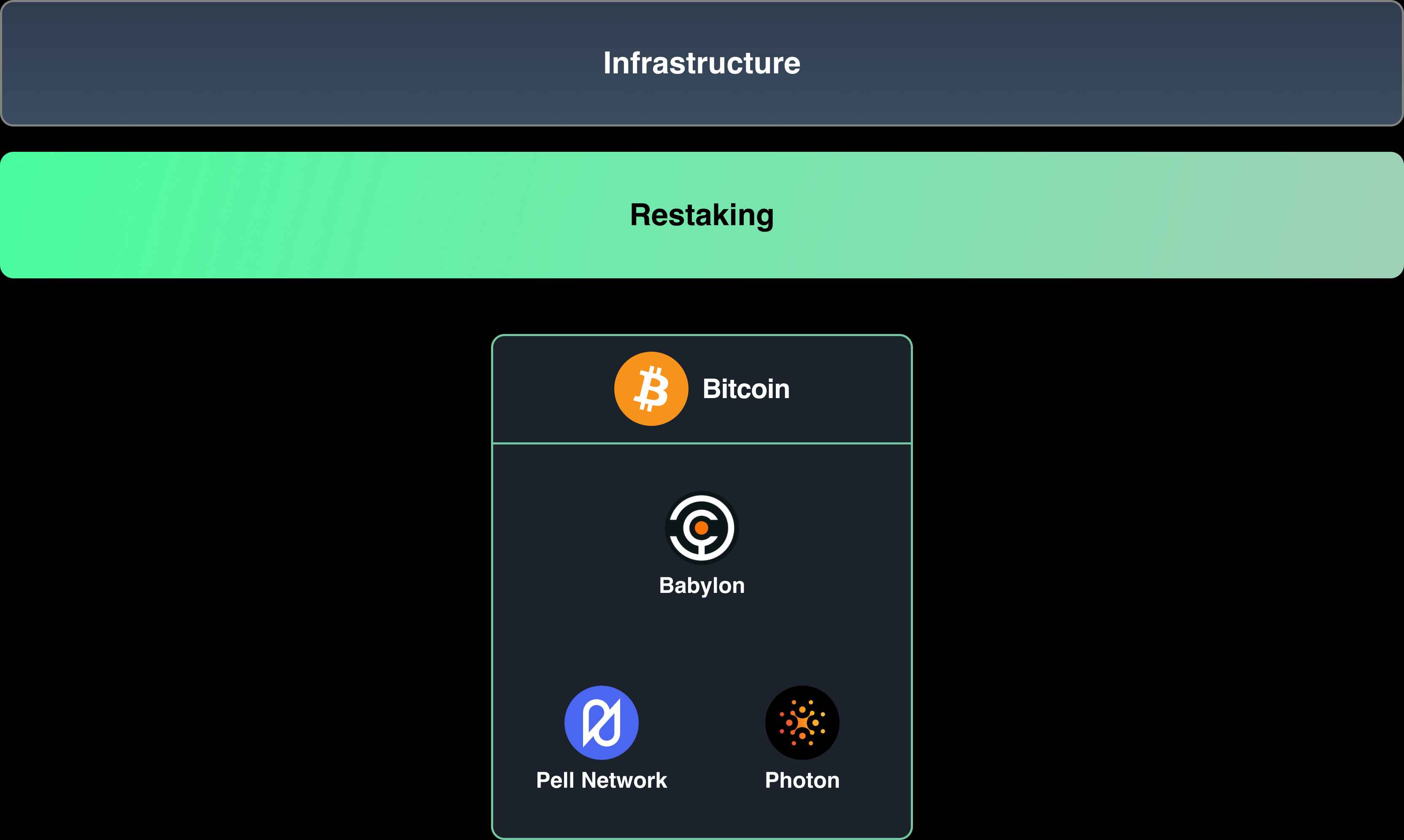
Bitcoin, as a PoW-based network, has different characteristics than PoS-based networks where staked assets directly correlate with security. Yet, Bitcoin's dominance in market capitalization has led to the development of restaking concepts that leverage Bitcoin’s economic security to generate additional revenue in other blockchains. Projects like Babylon, Pell Network, and Photon use various methods to integrate Bitcoin’s security into their own ecosystems, enhancing their scalability.
Bitcoin’s PoW system is one of the most secure in the world, making it a valuable asset for restaking infrastructure. Babylon leverages Bitcoin’s staking and restaking capabilities to enhance the security of other PoS blockchains. It transforms Bitcoin’s economic value into economic security, offering protection to other blockchains. It operates its own PoS chain using the Cosmos SDK, supporting non-custodial staking and restaking directly from the Bitcoin blockchain without the need for third-party trust.
Bitcoin also faces challenges with liquidity and opportunities for additional revenue. Pell Network was created to provide Bitcoin holders with liquidity and income opportunities, using cross-chain technology to integrate Bitcoin into DeFi ecosystems for additional yield.
Bitcoin’s most significant limitation is its lack of native smart contract support. While PoW offers strong security, its design makes internal programming difficult through smart contracts. Photon addresses this by extending Bitcoin’s capabilities to execute smart contracts without altering its core structure, implementing staking and restaking directly on the Bitcoin mainnet. This ensures that all staking and restaking-related processes are verified on the Bitcoin mainnet, maintaining Bitcoin's high security while offering flexible staking options.
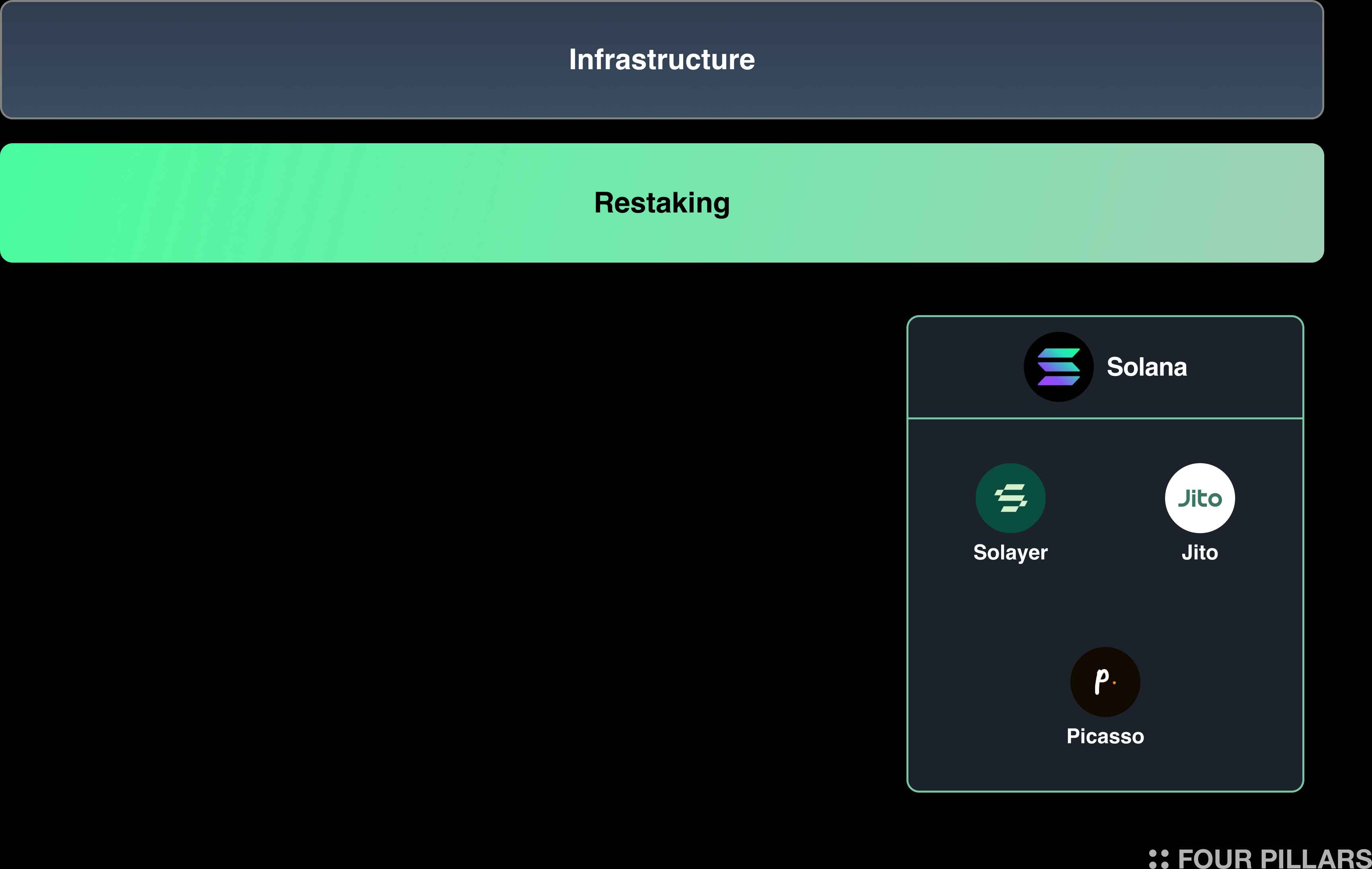
Solana’s reputation for high transaction throughput and low fees makes it an ideal environment for the growth of restaking infrastructure. Several projects in the Solana ecosystem have adopted restaking models to maximize these advantages.
Solana’s rapid growth has benefited validators directly, but distributing economic gains equitably across the broader Solana ecosystem has been a challenge. Solayer addresses this by offering restaking infrastructure that focuses on economic security and execution to expand app chain networks, providing a framework for staking native SOL and LSTs to support application-specific networks. It also allows users to repurpose their staked assets across other protocols to maximize returns.
Since Solayer draws inspiration from Ethereum’s restaking infrastructures, such as EigenLayer, it adopts a similar approach to user convenience while tailoring its restaking models to Solana’s unique attributes. This ultimately aims to drive the evolution of the Solana ecosystem.
Jito, already recognized for its role in Solana’s staking infrastructure, is working to expand its influence into the restaking space. Jito is building its restaking services on top of its established Solana infrastructure, garnering significant user interest for its potential scalability and reliability. Jito has a vision for utilizing SPL-based assets and optimizing MEV in the block creation process through restaking solutions. This increases security while providing restakers with greater earning opportunities.
Picasso complements Solana’s scalability by constructing an interchain expansion framework along with restaking mechanisms. Picasso is developing restaking layers not only for Solana but also for the Cosmos ecosystem, introducing an expanded concept that allows users to restake assets across multiple PoS networks. It aims to bring the restaking ecosystem, previously limited to Ethereum, into Solana and the Inter-Blockchain Communication (IBC) ecosystem, offering tailored restaking services with a grand vision.

In this way, restaking infrastructure projects on networks like Ethereum, Bitcoin, and Solana have developed by leveraging the strengths and weaknesses of their respective ecosystems. These projects demonstrate the potential of restaking infrastructure to play a significant role in the future of the blockchain ecosystem as their networks evolve.
Projects like Eigenlayer, Symbiotic, and Karak contribute significantly to solving Ethereum’s scalability issues and enhancing its security. Meanwhile, projects such as Babylon, Pell Network, and Photon leverage Bitcoin's security in various ways to further develop the concept of restaking. Additionally, projects like Solayer, Jito, and Picasso take advantage of Solana’s unique characteristics to operate restaking more efficiently, which positively impacts network scalability as well.
In this series, we explored the basics of restaking, defined the Restaking Stack, and examined the ecosystem of restaking infrastructure. Just like the growth of L2 solutions, restaking infrastructure is evolving around core blockchain networks, with ongoing efforts to enhance their functionality. With the increasing scale of the restaking ecosystem, represented by its growing TVL, an independent ecosystem is taking shape.
A significant factor in restaking's growth is its reliance on financial engineering rather than purely technical features. Unlike traditional staking infrastructure, restaking infrastructure is more flexible, accepting a broader range of asset types. However, this flexibility comes with new economic structures and risks that differ from conventional blockchain operations.
One major risk is that restaking is fundamentally a derivative financial asset rather than a core one. Some see restaking as a promising investment opportunity and a new advancement in crypto security, while others view it as a risky rehypothecation model with overly generous rewards. Additionally, restaking infrastructure has yet to undergo extreme market tests, such as the stress of a “Crypto Winter,” raising questions about its underlying stability.
If this stability is not proven, restaking may face criticisms for the risks inherent in its rehypothecation model. Moreover, the ecosystem has not yet expanded enough to establish the economies of scale needed for sustainable business models, which remains a challenge.
Nevertheless, the rapid growth of the restaking ecosystem, particularly around restaking infrastructure, is undeniable. The increasingly refined structure of the ecosystem supports this momentum. Concerns about profitability may be resolved as the ecosystem grows, ultimately positioning restaking infrastructure as a key player in crypto and blockchain security.
The categorization and definition of the ecosystem suggest that it is poised for its next phase of evolution. The emergence of the Restaking Stack reflects the significant progress made by various projects in developing narratives and products.
Now that restaking infrastructure is becoming well-established, the focus will shift to restaking platforms and applications, which will determine the success or failure of the restaking ecosystem’s mass adoption. Therefore, the next part of this series will delve deeper into restaking platforms and applications, exploring their potential to drive widespread adoption in the ecosystem.
Dive into 'Narratives' that will be important in the next year